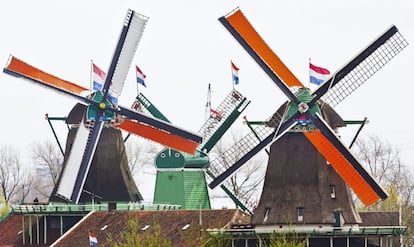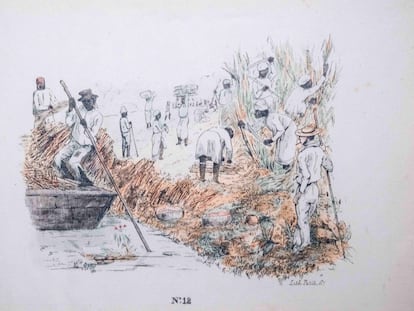The return of the Dutch miller
The post-Covid boom in confectionery and bakery items has revived an industry that has been key to the Netherlands’ economy for centuries


The Dutch began building windmills to pump water around 1200, and then came those for grinding grain. In the 19th century, at full capacity, there were around 10,000 of these constructions dotting the Netherlands’ flat landscape. Indispensable in their day for the development of agriculture and industry, and for keeping the land dry, about 1,200 mills remain now. During the Covid-19 pandemic, the temporary lockdown prompted people to start baking more, and since then the trend of obtaining flour from millers has been on the rise.
At present, 1,624 Dutch people have the credential to maintain a windmill at full capacity, and another 87 run water mills (there are also tourist mills). Most of them are volunteers who work in their spare time, and only about 50 millers operate as full-time professionals who earn money from their work. The training classes to qualify take two years, and the program pays special attention to safety measures. All applicants must pass theoretical and practical tests.
Ten percent of the students are women; in 1985, there were only two female apprentices. Little by little, the stereotype of the lone male miller of a certain age is losing relevance and a new generation of amateurs is emerging. There are a hundred or so instructors; when a course is successfully completed, students receive a certificate from the Dutch Millers’ Association. “We add about 150 new members a year, and the central government and the provincial and local authorities contribute funds, because the mills are a tradition and without care they spoil quickly,” says guild secretary Tom Kreuning.
The major role of bread
There are some 1,100 windmills and a hundred more watermills scattered around the country. While they have been used over the years to produce grain, cut wood for ships and houses, grind seeds for oil, and control the water level in a field, in recent years the preferred product is freshly ground flour. This is largely due to bread’s prominent role in Dutch life. According to a 2018 survey conducted by the Netherlands Baking Center (NBC), 74% of the population considers it a part of their cultural heritage. Bread is more popular than fruit, muesli or vegetable smoothies, and makes up the bulk of the most common lunch. NBC advises the baking industry, and the survey included 800 respondents. In 2023, in another similar survey, 88% of the responses pointed to whole wheat bread as the bread of choice. Since most mill graduates are volunteers who cover the cost of personal equipment, the earnings of those who are self-employed depend on how much they have milled per month.
Whole wheat flour is a protected label in the Netherlands. Millers claim that by not separating the grain from the germ of the cereal — the reproductive part that germinates — it is more flavorful and nutritious. There are mills with websites as well as a physical and digital store that sell a wide variety of products. There is flour made of wheat, spelt, rye, buckwheat; corn flour; wheat, oat and barley flakes; wheat bran, corn bran and wheat semolina bran; dry yeast; flax, pumpkin, sesame, poppy, sunflower and mustard seed...
Through the beginning of the 20th century, Dutch mills worked regularly until the progressive introduction of steam engines and diesel and electric motors. In the last hundred years, nearly 9,000 of these unique buildings, which laid the foundations of Dutch industry, have disappeared. Today, in addition to being the hallmark of the Dutch landscape, the mills are considered monuments, and some of them can be visited on National Mill Day, which will be held on the weekend of May 11 and 12.
Sign up for our weekly newsletter to get more English-language news coverage from EL PAÍS USA Edition
Tu suscripción se está usando en otro dispositivo
¿Quieres añadir otro usuario a tu suscripción?
Si continúas leyendo en este dispositivo, no se podrá leer en el otro.
FlechaTu suscripción se está usando en otro dispositivo y solo puedes acceder a EL PAÍS desde un dispositivo a la vez.
Si quieres compartir tu cuenta, cambia tu suscripción a la modalidad Premium, así podrás añadir otro usuario. Cada uno accederá con su propia cuenta de email, lo que os permitirá personalizar vuestra experiencia en EL PAÍS.
¿Tienes una suscripción de empresa? Accede aquí para contratar más cuentas.
En el caso de no saber quién está usando tu cuenta, te recomendamos cambiar tu contraseña aquí.
Si decides continuar compartiendo tu cuenta, este mensaje se mostrará en tu dispositivo y en el de la otra persona que está usando tu cuenta de forma indefinida, afectando a tu experiencia de lectura. Puedes consultar aquí los términos y condiciones de la suscripción digital.
More information
Archived In
Últimas noticias
Most viewed
- Reinhard Genzel, Nobel laureate in physics: ‘One-minute videos will never give you the truth’
- Oona Chaplin: ‘I told James Cameron that I was living in a treehouse and starting a permaculture project with a friend’
- Pablo Escobar’s hippos: A serious environmental problem, 40 years on
- Why we lost the habit of sleeping in two segments and how that changed our sense of time
- Chevy Chase, the beloved comedian who was a monster off camera: ‘Not everyone hated him, just the people who’ve worked with him’










































